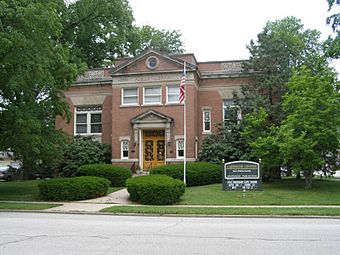Rensselaer Carnegie Library facts for kids
Quick facts for kids |
|
|
Rensselaer Carnegie Library
|
|
 |
|
| Location | 301 N. Van Rensselaer St., Rensselaer, Indiana |
|---|---|
| Area | less than one acre |
| Built | 1905 |
| Architect | Weatherhogg, Charles; Rush and Warren |
| Architectural style | Late Gothic Revival |
| NRHP reference No. | 94000233 |
| Added to NRHP | March 17, 1994 |
The Rensselaer Carnegie Library is a special building in Rensselaer, Indiana. It was built a long time ago, in 1905. This building is so important that it was added to the National Register of Historic Places in 1994.
Even though it's called a library, it hasn't been a library since 1992. Today, it's home to the Prairie Arts Council. This group uses the building for plays, concerts, and other fun performing arts events.
Contents
What Does the Library Look Like?
The Rensselaer Carnegie Library was built between 1904 and 1905. It looks like a big, strong building made of brick and stone. It has one main floor, but it sits on a raised basement. This makes the building look taller, almost like it has two or three stories!
The building is shaped mostly like a square. In the middle of the front, there's a part that sticks out. This is where the main entrance is. The roof slopes down towards the back, but you can't see it from the front because of a decorative wall called a balustrade.
Outside Details
The outside walls are made of light brown bricks called "Hobart" buff face brick. These bricks are laid in a pattern called common bond. There are also fancy details made from smooth, cut limestone.
A set of stairs leads up to the main door. The doorway itself is very grand. It has a special design above it called a broken pediment. This is held up by decorative stone supports. On either side of the door, there are small, narrow windows.
Above the door, you can see a stone band with Roman letters carved into it. It says "MDCCC PUBLIC LIBRARY 01111". This means it was a public library. Above this, there's another triangular stone design with a round window in the middle. This round window has a stone wreath around it.
Windows and Walls
On both sides of the main entrance, there are large windows. These windows have heavy stone tops. Below them, at the basement level, are more windows.
The main floor windows are very tall. They have stone tablets underneath them. Above each pair of windows, there are continuous glass sections with a criss-cross pattern. Each window pair also has a flat stone arch above it.
The top part of the building has a stone border, a plain brick section, and a stone ledge. A brick wall with stone on top hides the roofline. In this wall, there are stone panels that match the criss-cross pattern from the windows below.
Cornerstone and Sides
You can find the cornerstone of the building at the southwest corner. A cornerstone is a special stone laid during construction. It tells us when the building was started and by whom. This one says it was laid on July 13, 1904, by the Grand Master of Indiana, with help from a local group called Prairie Lodge No. 125 F.& A.M. It also names the architect, C.R. Weatherhogg.
The sides of the library building have three sections of windows, just like the front. Some of the basement windows on the sides and back have been filled in with bricks. The back of the building is similar to the sides, but it has a chimney and doesn't have the decorative wall hiding the roof. A small wooden entrance has been added to the basement level at the back.
Inside the Library
When you walk through the main door, you enter a foyer. This is a tall space with stairs. To the left, the stairs go down to the basement. To the right, they go up to the main floor.
Much of the original oak wood in the foyer is still there. This includes the wood panels on the lower part of the walls and the decorative stair rail. The stair rail has fancy posts and turned balusters. The wood frames around the doors and windows are also original.
While some changes have been made, like new lighting and ceiling tiles, many of the original built-in bookcases are still in place. Sadly, the beautiful stained glass skylight that used to be there was removed.
The Rensselaer Library is a great example of a Carnegie library building. These libraries were built all over the world with money from a rich businessman named Andrew Carnegie. The building was designed by a famous architect from Fort Wayne, Charles Weatherhogg. It's considered one of the best examples of Neo-Classical Revival style architecture in Rensselaer.
Gallery





